Simon Guerrier's Blog, page 99
October 6, 2011
AAAGH! and the Cybermats!
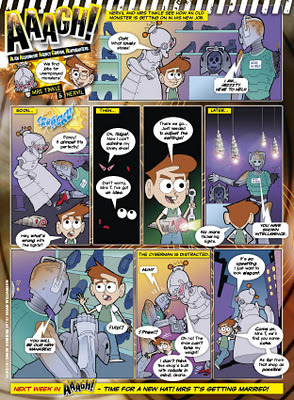 Another AAAGH!, this time from Doctor Who Adventures issues #237, published just a few days after the episode Closing Time, where the Doctor battled Cybermats in a department store.
Another AAAGH!, this time from Doctor Who Adventures issues #237, published just a few days after the episode Closing Time, where the Doctor battled Cybermats in a department store.In issue #238, out in all good shops today, Nervil is a guest at the wedding of Mrs Tinkle...
The script of this episode is by me, illustrated by Brian Williamson and edited by Paul Lang and Natalie Barnes. All my AAAGH!s are posted here by kind permission.
Incidentally, there's a review of the event I did last week, discussing Cybermats, Doctor Who and Egyptian archaeology with Christopher Frayling and John J Johnston.
October 4, 2011
Doctor Who - The Age of Heroes
We knocked this back and forth between us for a few days before agreeing a final outline, but this still contains spoilers if you've not read the book or heard the audio version read by Debbie Chazen.
Doctor Who – The Age of Heroes
Simon Guerrier
27 March 2008
June is 17 and not very confident about her forthcoming A-levels. She's on a college trip to the Palace of Westminster (not, she has learnt that morning, the "Houses of Parliament") when she spots the Doctor. He must be important because he doesn't have a security pass – not even the pastel-coloured stickers that they give to the tourists – and yet the policemen with machine guns let him go where he likes.
June dares to follow him and saves his life when a monster jumps out on him. The Doctor stops the monster by talking nonsense. It feeds on nonsense and illogic – so the Palace is like a restaurant. The Doctor owes June a favour and she asks if he can help with her essay. She's got to write about the history of democracy.
Chapter 1
The Doctor says he knows a thing or two about history. Seeing history live – touching it, smelling it, getting your fingers dirty – is more exciting than dusty old books. But as they set the coordinates for the golden age of ancient Athens, he picks up a signal from an alien spaceship that's got into trouble. They're going to have to make a quick detour.
They arrive in Athens, 1687 AD. The Venetians are at war with the Turks. There's a Turkish garrison in the temple up on the rock overlooking the town – the Parthenon is pretty much complete and looking good for its 2,000 years. For a brief moment June and the Doctor are separated and June realises she could be stranded in the primitive past. There's something odd about the war though; both sides accusing the other of using strange and magical weapons.
The Doctor and June are reunited. They get away from the fighting Turks and Venetians and investigate the distress signal. They soon discover a party of Slitheen.
Chapter 2
But it emerges that they're not there to muck up the war. They just want to keep everyone away from a grotto of stalactites and stalagmites which they're using for some nefarious purpose.
The Slitheen are, though, fascinated by the Doctor and June – who must, they think, be using some kind of warp-core technology to journey back in time. And even schoolkids know that warp-cores are dangerously unstable. So the Doctor finds himself arrested as a dangerous maniac, when that's what he normally accuses the Slitheen of.
June helps the Doctor escape, but rather than running away the Doctor insists they find out what the Slitheen are up to. It turns out the stalactites are calcified Slitheen – these Slitheen's ancestors who were on Earth thousands of years ago.
Chapter 3
As they get older, Slitheen suffer from hardening of their soft tissues – a bit like we suffer from hardening of the arteries. They slowly lose the moisture inside themselves, and mineral deposits build up until they can't move. The early affects are like Calciphylaxis, with brittle skin etc. And then they harden out entirely and become like statues.
At first the Doctor assumes it is some kind of rescue operation. But the young Slitheen want to know what happened to all the loot they never inherited. When the older Slitheen won't tell them, they throw tantrums and blow things up.
Chapter 4
The Doctor has to intercede. The Slitheen spaceship, hidden on the top of the Acropolis, explodes. This blows up the Parthenon – history will assume the Venetians did it.
Chapter 5
The ancient Slitheen will not survive long. But they recognise the Doctor and June, having met them thousands of years before. They're dying, and realise the Doctor hasn't met them yet. They say he'll understand what happened to the loot when he goes back to meet them. And they die. June is upset by this, and the Doctor admits he's not used to feeling sorry for Slitheen. They're a very strange family.
But now it seems he and June have to go back in time to meet these Slitheen in the first place.
The Doctor looks through history for the Slitheen signals. He finds them – roughly the same place but about 3,000 years before. And that's worrying because mankind is quite impressionable back then. Sophisticated, space-faring aliens mucking around with the ancient Greeks could do terrible things to the development of human history.
Having landed in about 1,500 BC, the Doctor does a scan for aliens. And there are nearly 2,000 of them in the area. They step out into a world where aliens are living amongst the humans quite openly. Spaceships and high technology can be seen everywhere.
Chapter 6
There's a great tourist industry running to the place, all kinds of aliens getting to mix with humanity when it hasn't even sussed out basic architectural stuff like the arch. These aliens aren't changing history. They've always been there – they're the Gods and monsters of Ancient Myth.
At first it seems fun, but June is horrified by how the aliens pretend to be Gods to the locals. And some aliens are very badly behaved, frying the humans with laser guns just for a bit of a laugh.
The Doctor just runs off. June tries to stop some aliens picking on the humans. The aliens turn on her. She is going to be fried.
Chapter 7
The Doctor arrives dragging some Slitheen with him, insisting he and his friend didn't pay for their tickets expecting to get fried. He waves his psychic paper around and people assume he's a tourist, too. And the Slitheen intercede: it's not done to fry fellow holiday-makers.
June recognises these Slitheen. The ancient Slitheen they met in 1687 turn out to be running the tourism. They are young and sprightly hucksters, and don't take kindly to the Doctor and June interfering.
They invite the Doctor and June back to their office for a glass of something to make up for the inconvenience. The Doctor is keen to find out more of what they're up to so agrees to go along. On the way, the Slitheen explain the terrible complexities of this project – how they use accelerators to grow food very fast to feed the demands of the tourists, how the bookings system keeps breaking down… all the rigours of a small business.
But the invitation to drinks is really a trap. The Slitheen know psychic paper when they see it. And they assume the Doctor is some kind of anti-time-travel protestor, and the one who has been causing all the earthquakes. For the sake of saving humanity, the Slitheen will now execute him and June.
Chapter 8
The Doctor and June escape death at the hands of the Slitheen when a half-man, half-snake called Cecrops comes to complain about how some of the other tourists are treating the locals. The Slitheen insist they've got a contract with the local kings that strictly agrees the terms of tourists' behaviour.
Humans are to be respected. The Doctor uses this point of law to get himself and June released. The Slitheen get very nervous the moment anyone mentions lawyers.
Cecrops is very embarrassed about the tourist trade. He is a real humanophile, though his enthusiasm for how the little ape people slowly puzzle out problems doesn't go down very well with June who finds him patronising.
The Doctor asks about these anti-time-travel protests, which people assume are some sort of politically correct statement that humans should be left alone to develop. Cecrops explains that he's got problems with that ethos, too – the humans' lives are nasty, brutal and short. June is surprised to discover she would be considered in late middle-age by being 17.
But anyway, Cecrops hasn't seen and sabotage. He's seen natural phenonema – earthquakes and things. It's just the earthquakes have been really bad recently. And, as if on cue, there's a terrible earthquake.
Chapter 9
The Doctor, June and Cecrops try to help people. But the Doctor insists this isn't any ordinary earthquake. It's a warp shift; the side effect of unstable warp core technology. June remembers the seventeenth-century Slitheen saying even children knew that was dangerous.
They investigate. Yes, the Slitheen here are using some dodgily acquired warp core technology to bring their tourists here. And they've been greedy; the system is exhausted and sagging at the edges. There are earthquakes and other strange phenomena. The Doctor tries to fix things, but the Slitheen catch him and it's them trying to stop him that pulls the plug on everything. There's not an explosion; instead the whole world seems to be falling apart.
Chapter 10
A widescreen disaster movie. The huge explosion causes a massive flood right across the Mediterranean. As described in the Greek legend of Deucalion, the rivers swell over the coastal plains and engulf the foothills, washing everything clean (the legend might also be the same route as that of Noah and Utnapishtim, but we'll skirt round saying so explicitly). From the Acropolis they watch the great tidal wave coming in, and thousands are killed.
(I'll probably expand this action stuff; have June separated from the Doctor and having to be a bit of a heroine. Have the Slitheen show that, though they're greedy and dangerous, they don't actually mean any harm.)
Chapter 11
The floods pass; the climate and timeline just diffusing the kinks in the system. The warp core technology is wrecked so all the alien holiday makers who've survived now find that they are stranded. Facing this mob, and the thought of insurance claims etc., the surviving Slitheen throw themselves off the Acropolis into the receding waters – ostensibly to their deaths.
June can't believe they wouldn't have had an emergency escape plan, and the Doctor is delighted. He leads the aliens to the cave where, in 2,000 years, there'll be Slitheen-shaped stalagmites. There is a small vortex pod hidden at the back of the cave. The Doctor messes with its dimensions until it's big enough to carry everyone.
But Cecrops is one of a few aliens who want to stay. If they don't help clear up some of this mess, he says, the humans here are all going to die.
Chapter 12
June is suspicious of the Doctor – he seems happy to let the aliens believe that if they don't take the vortex pod they'll be stranded here forever. Why won't he mention the TARDIS? But she has come to know him and she supposes he must have a good reason. Anyway, it looks like the aliens could do these humans some good.
Cecrops adopts the daughters of the dead Athenian king Actaeus. (In legend, the half-man, half-fish Cecrops, first King of Athens, taught the Athenians marriage, reading, writing and ceremonial burial.)
But with the waters all round the Acropolis, how are humans going to survive? The Doctor uses his sonic screwdriver to draw water from the rocks – a spring of not very pleasant-tasting water, but water all the same. And June has seen how the Slitheen provided food for the tourists. She points their accelerator at the rock and up springs an olive tree. It's not quite what she had in mind to feed everybody, but the olives will serve as an appetizer. (This makes the Doctor Poseidon and June Athene, I think.)
There's a party later that evening. It looks like things are going to work out. With the loss of the aliens and creatures, a new age begins. One not of Gods and monsters but of extraordinary human beings. The age of heroes.
But the Doctor is still not content. He's not sure history is quite on course as it should be. And anyway he promised June he'd show her real democracy at work.
Chapter 13
The TARDIS arrives in 480 BC to see the Parthenon being built and the golden age of Athens in full swing. June is appalled to discover that 17 is still considered quite old here. And that women aren't going to get the vote until 1952 AD.
The Doctor and June soon get separated, but June has learnt a lot in her adventures thus far and is okay now to explore on her own. It seems the Gods and monsters are remembered as legends. But the town isn't known as Athens – it's called Cecropia.
She thinks the Doctor will make for the Acropolis to see the building work going on. And she's curious to see the view of Cecropia up there. At first the male builders don't see what business it is of hers, but their old, fat foreman seems pleased by June's interest and offers to show her around.
But as soon as they're on their own, the fat old man unzips his forehead. Creaky and old folk, it's the last of the huckstering Slitheen – stranded on Earth for 1,000 years.
Chapter 14
The Slitheen have been hidden on Earth for 1,000 years. They had tried to get rescued at first, and then they'd seen the difference Cecrops was making with the primitive humans. They helped out – not pushing them or inventing anything for them, but getting them to write things down so the things humans learnt could be passed on. They've got people telling stories, sharing ideas.
And it's hard work because humans keep having wars and things. The Parthenon is being built on the ruins of a previous one razed to the ground just a few years ago. And the Slitheen are running out of time. They're calcifying, becoming the stalagmites June has seen in the future. If they could reach their people there are possible cures, but they're just going to dry out.
June knows it has to be like this because she's seen what happens. But the Slitheen are glad to have played their part, to have written themselves into history even if no one will ever know. They're glad that June knows.
She leaves the grotto of dying Slitheen to find the Doctor waiting for her. He left her to discover the truth for herself – just as the aliens had let humans develop their own way. Now the lesson is over and its time for June to go back home.
The Doctor takes her back to the Palace of Westminster the same moment that she left. But she's a different person now; better and wiser for what she's seen.
Only when the Doctor's gone does she realise she can't use any of what she's seen in her essay. She hurries off to rejoin her college mates.
September 29, 2011
AAAGH! and the Shining
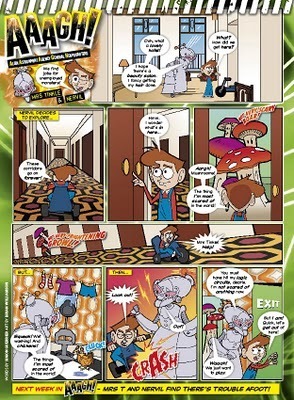 Another AAAGH!, this one from Doctor Who Adventures issue #236, out a few days after the Doctor Who episode The God Complex. Issue #237, in shops from today, features Cybermen and Cybermats. I'll be wrestling with Cybermats live on stage tonight with Sir Christopher Frayling.
Another AAAGH!, this one from Doctor Who Adventures issue #236, out a few days after the Doctor Who episode The God Complex. Issue #237, in shops from today, features Cybermen and Cybermats. I'll be wrestling with Cybermats live on stage tonight with Sir Christopher Frayling.As ever, the above strip was written by me, illustrated by the amazing Brian Williamson and edited by Paul Lang and Natalie Barnes - who also have kind permission for me to post it here. You can also read all my AAAGH!s.
September 26, 2011
Sayle
Stalin Ate My Homework is a smart, funny and self-effacing autobiography by Alexei Sayle. It covers the years 1952 (when Sayle was born, on the same day that eggs stopped being rationed) to 1969 (when he started at Southport College of Art – his mum having sat the interview for him). There's lots of this kind of odd, engaging detail in the 53 short chapters, Sayle's life and times sketched out in fleeting glimpses.
Sayle was named after Maxim Gorsky. His parents, Joe and Molly, were Communists – dedicated to the party, even after the brutal repression of the uprising in Hungary. Sayle's good at explaining the different factions, the personalities and the culture of the left. I found his explanation for how his parents could condone events in Hungary (seeing it as a test of their faith in totalitarianism), and then his own leanings towards the Maoists in the 60s, really illuminating of the politics of the period – I've not seen it spelt out so simply before. He manages to address the theory and the personalities involved, and get some jokes in, too.
Joe worked for British Rail and used his free pass to take his family all across Europe, so it's also a travel memoir. Again, the family's visits to Communist countries – at the height of the Cold War – are fascinating. Sayle notes the irony of a family so dedicated to totalitarian equality lording it up as guests of the Party, and the pang of having to return to ordinary living when these holidays were over.
While there's a passion for the politics, there's also a delight in human frailty and life's strangeness, and he's good on acknowledging his own weaknesses, anger and stupidity. There's lots on the way that Liverpool changed after the war - linking the architecture to the communities living around and in it. He's good at unpicking the hippy and peace movements – young guys who were terrible at organising anything and who seemed mostly in it for the sex. It's all told with an endearing sense of his own envy and confusion, belying the usual cool shtick of the 60s.
The book is dedicated "to Molly", and it's as much Sayle's parents' story as his own. Molly is a perfect comic creation – argumentative, sweary and utterly adored by the writer. Joe has an easy, carefree faith in the Party ensuring everything will be all right in the end and seems to hold it as an article of that faith not to get on a train until it's already moving. He and Molly cut sparks and are devoted to one another.
Another child might have resented his "famous" parents overshadowing his own identity - just as he starts going to pubs, so does Molly and she holds court there. I wondered if there might be a link between the nerdy, shy boy who is known because of his parents, and the bullshitting that seems to pervade his teens. Is it an effort to define himself on his own terms - to find a way to get attention for something he's doing himself? But perhaps that would only work if Sayle were more hostile or resentful.
The glowing affection for Molly and Joe makes hints about Joe's declining health all the more powerful. It's what makes this such an absorbing and feel-good read. But the following passage is worth quoting in full for its mix of history, comedy and gut-wrenching pathos. I find it utterly haunting, and a sign that this isn't just a funny, daft book but something really special.
(Wikipedia says Hanratty wasn't the last person executed in the country - I assume that's dramatic licence.)"The Bedfordshire CID had come to our house to interview my father about the murder of Michael Gregsten at Deadman's Hill on the A6 in Bedfordshire, on 22 August 1961, along with the rape and shooting of his lover, Valerie Storie. James Hanratty, a professional car thief, had been charged with the crimes. Hanratty's alibi was that at the time of the murder he had been in the Welsh seaside town of Rhyl, staying in a boarding house named Ingledene run by a woman called Mrs Jones, in the attic room, which had a green bath.
The police had discovered that Joe had stayed at Ingledene between 21 and 24 August, in the small front room on the first floor. He was there on behalf of the NUR, taking part in a recruitment drive. In his book Who Killed Hanratty? Paul Foot describes Joe as 'the most important witness from the prosecution point of view'. He says that Joe saw no sign of Hanratty, although he admits, 'he was out on union business from dawn to dusk'. Which sounds typical enough.
Hanratty's trial began at Bedfordshire Assizes on 22 January 1962. On 17 February he was convicted of murder and sentenced to death. Hanratty's appeal was dismissed on 9 March, and despite a petition signed by more than ninety thousand people he was hanged at Bedford on 4 April 1962, still protesting his innocence.
Joe was away for a week attending the trial in Bedford. One night Molly spoke to him on the phone, and when I asked how he was she replied that he had told her he was frightened. I asked her what my father was frightened of, and she said he was worried that Hanratty might have criminal friends who could harm him in some way.
When he returned from the trial Joe told us that what had upset him most was that he had been the final witness called in the trial. He realised that the last person Hanratty had heard testifying against him, the last person he had seen on the stand, the final person confirming his fate, was Joe Sayle. After that he was taken down, sentenced and hanged two months later. The last witness to testify against the last person executed in Britain was my father. Though he never talked about it, since he was such a good-natured man that must have been a heavy burden for him to bear.
Over the next few years the case did not go away: prosecution witnesses attempted or committed suicide and several books were written about the case, including one by Lord Russell of Liverpool. There were newspaper articles, radio and TV programmes, all of them contesting the soundness of Hanratty's conviction and reminding Joe that he might have taken part in the execution of an innocent man. When one of those programmes came on we did not shout at the TV as we usually did but simply changed the channel and said nothing. In 2002, the murder conviction of James Hanratty was upheld by the Court of Appeal which ruled that new DNA evidence established his guilt 'beyond doubt'. So the coppers got it right."
Alexei Sayle, Stalin Ate My Homework, pp. 113-5.
September 22, 2011
The AAAGH! Who Waited
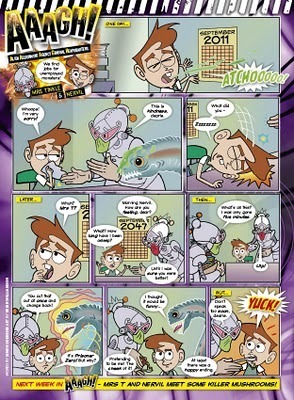 Here's the AAAGH! from Doctor Who Adventures #236, last week, nicked broadly from The Girl Who Waited but with a guest appearance by Prisoner Zero. The new issue, #237, is out today and features a homage to The Shining which I'm particularly proud of for a magazine aimed at 6-12 year-olds.
Here's the AAAGH! from Doctor Who Adventures #236, last week, nicked broadly from The Girl Who Waited but with a guest appearance by Prisoner Zero. The new issue, #237, is out today and features a homage to The Shining which I'm particularly proud of for a magazine aimed at 6-12 year-olds.As always, script by me, art by the amazing Brian Williamson and edited by Paul Lang and Natalie Barnes, who also gave kind permission to post this here. Why not read all my AAAGH!s so far?
September 16, 2011
Wheeler
Wheeler himself calls the book,
"an average life in one of the great formative periods of history".He deftly brings to life service in two World Wars and the violence of the partitioning of India up close – there's a thrilling account of him rescuing a Muslim colleague's family from a siege only for them to tick him off for not bringing their luggage, too. All in all, it's a rather chappish rollick through his life, with excerpts from diaries and correspondence to add vivid contemporary detail. It's generally fun and good-humoured, with an eye for the absurd character or moment. At the same time, he's forthright in his opinions.
Sir Mortimer Wheeler, Still Digging – Adventures in Archaeology (1958 [55]), p 9.
"The British Museum I abjured [as a young man] as I abjure it today, a place that suffers from a sort of spiritual cataract and out-stares the visitor with unseeing eyes."My 1958 edition adds a footnote to this view:
"I regret this remark. It was written before I became a Trustee of the British Museum and, had truth permitted, I should have deleted it."That forthrightness is matched by an unapologetic vocabulary when speaking of other nations. There's plenty, for example, on the habits of "the Hun". Yet for all the racial terminology, he's also strikingly tolerant for his time. The following passage is a typical mix:
Ibid., p. 24.
"I have in mind the sixty-one students who flocked to me from the universities of India and from the archaeological departments of the Indian states: swarthy Muslims from the North-West Frontier and the Punjab, little round-faced talkative Bengalis, quick-witted Madrasis, dark southerners from Cochin and Travancore. Also, today – only a few years later – such an assemblage of races, tongues and creeds would no longer be feasible. Religious and political barriers have split asunder those who in 1944 worked together with single purpose and common understanding."It's not just that he wished other races would bally well get along with one another. He's an enthusiastic participant in World War Two, but when the Eighth Army pushes the Germans out of Libya, he's happy to work with Italian – that is, enemy – and Libyan archaeologists, freely acknowledging their superior skill and expertise. He also readily credits the many women archaeologists he's worked with over the years, and is carefully to cite both their unmarried and married names. Foreigners, natives and ladies are treated as equals – all that matters is that they're up to the job.
Ibid., p. 174.
Wheeler delights in archaeology as a proper, bona fide science, describing particularly fine discoveries or developments in method, and reporting with special glee when some new piece of evidence torpedoes a long-standing theory. He's surprisingly modest about his own contributions to the field – such as dividing digs into grids. Acutely aware that so many of his peers had been killed in the First World War, he concludes that his eminence in the profession,
"was the outcome of circumstance, not merit".There's a shadow over much of his otherwise jolly outlook. As well as the wars, there's the death of Wheeler's first wife, Tessa, in 1936. Wheeler was away on a dig at the time. His account of learning the news while heading back to England and seeing it in the paper is told with exemplary restraint, which makes it all the more haunting.
Ibid., p. 206.
He's quick to credit Tessa's contributions to several of his digs. But there's just a single, brief mention (on page 183) of Margaret, his wife at the time of writing, and no mention at all of the wife in between.
As I posted a few weeks back, Mavis was drawn and bedded by Augustus John – before and perhaps after her marriage to Wheeler. Wheeler divorced her in 1942 having caught her with another lover and excised her completely from his memoirs. John, though, gets a mention several times – and even gave the book it's title. (There's no mention of the duel.)
Wheeler is otherwise cagey on the subject of girls. Apart from Tessa, the only romantic entanglement is a newly liberated Italian contessa, who calls him "the General" before he escapes her advances. He's such an old rascal otherwise I suspect his private life might not have been nearly so tame as the book implies.
There are plenty of vignettes about the celebrities he encountered – such as eminent archaeologists Pitt-Rivers and Petrie. But Wheeler was also clearly interested in everyone, no matter their origin or status. The appeal here is as much his perspective as what he did or who he met. As an archaeologist and war-veteran, he takes the long view and sees his own insignificance in history.
"At its best, this book will be little more than a scrapbook: probably few lives are otherwise, save those of the very successful or the very humdrum."But there's also a compelling philosophy behind these rag-tag adventures. On the same page, he says,
"I do not believe in much except hard work, which serves as an antidote to disillusion and a substitute for faith."He says, but for John and his publishers, he'd have called his book "Twenty Years Asleep" - based on the line in Don Juan that we miss a whole third of our lives. Wheeler is a fidget, too eager to get out and explore all the fascinating stuff. His enthusiasm engaged generations of young archaeologists all around the world, and then the TV-viewing public. That delight in rigorous investigation, and the wry, self-mocking twinkle in his eye, is just as arresting today.
Ibid., p. 9.
"Whilst adoring luxury I abhor waste, and am firmly of the view that most of us are unconscionably wasteful in this matter of sleep. It must at the same time be added that I have been made aware of other opinions."
Ibid., p. 205.
September 15, 2011
AAAGH! and Bernard
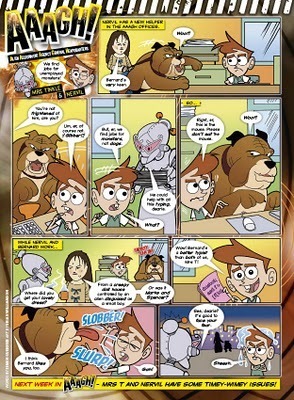 Here's the AAAGH! from issue #234 of Doctor Who Adventures, out a few days after the broadcast of Night Terrors (in which a small boy who is scared of Peg Dolls and a dog must overcome his fears). Issue #235 - out in all good shops today - features some timey-wimey issues that might just possibly be inspired by The Girl Who Waited.
Here's the AAAGH! from issue #234 of Doctor Who Adventures, out a few days after the broadcast of Night Terrors (in which a small boy who is scared of Peg Dolls and a dog must overcome his fears). Issue #235 - out in all good shops today - features some timey-wimey issues that might just possibly be inspired by The Girl Who Waited.As ever, the script is by me, the art is by Brian Williamson and the strip is edited by Paul Lang and Natalie Barnes - and posted here by kind permission. You can also read all my AAAGH!s so far.
September 10, 2011
Plugs and plugs
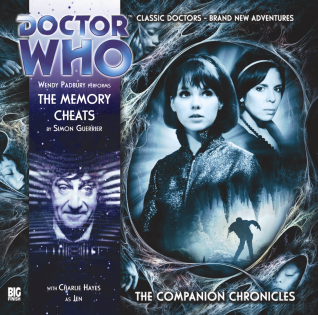
Sorry - a pluggy post. I have a new CD out this month - Doctor Who and the Memory Cheats starring Wendy Padbury as Zoe Heriot and Charlie Hayes (Wendy's daughter) as Jen. The spooky cover is by clever Marcus at Amazing15 (who I also sometimes work with doing daftness for Doctor Who Adventures). Here is the blurb:
Zoe Heriot remembers everything. But she remembers nothing.The story owes a bit to Col. Bailey's Mission to Tashkent, which I have blogged about before. I'm interviewed about the CD in the new issue of free Vortex magazine (issue #31). Look, my name is even on the cover, as if I am a draw.
A genius with instant recall, Zoe's mind has been purged of her memories of travelling with the Doctor and Jamie in the TARDIS. And years later she is in deep trouble – prosecuted by the mysterious company that has evidence that she has travelled in Space and Time.
Except Zoe knows they're wrong.
Aren't they?
But if that's the case, why is there proof that Zoe was in Uzbekistan in 1919.
Can the memory cheat?
My next CD is out in November. Doctor Who and the First Wave is the final part of my trilogy starring Peter Purves and Tom Allen. Me and Will Howells went to see Tom's show in as part of the Scipmylo festival in Shoreditch last night, a chat show with guests Stephen K Amos, Katherine Ryan, Ed Byrne and some bloke called Matt Smith.
Will, Nimbos and the Dr will be on Only Connect on BBC Four on Monday. Oh, and there is a Twitter competition to win tickets to the first screening of my short film Cleaning Up.
Think that's everything.
September 9, 2011
AAAGH! and the Teselecta
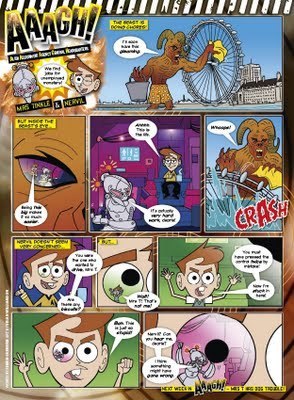
Another AAAGH!, this from last week's Doctor Who Adventures, issue #233. As always, the strip is illustrated by Brian Williamson and edited by Paul Lang and Natalie Barnes - who gave kind permission for me to post it here.
Issue #234 - currently in all good shops - features another AAAGH! by me, with a Peg Doll and a dog called Bernard. You can also catch up on all my previous AAAGH!s.
September 6, 2011
Trailer and details for my short film, Cleaning Up
Cleaning Up - Official Trailer from Guerrier Brothers on Vimeo.
Full cast and crew for Cleaning Up - a short thriller starring Mark Gatiss and Louise Jameson - is now up on the spangly official Guerrier brothersTM webventure. Why not follow @cleaningup_film on Twitter and join the Facebook Cleaning Up experience journey thing.
Screenings start next week with a showing at the Cambridge Film Festival at 1pm on Saturday 17 September, followed by a screening at the Branchage Film Festival in Jersey at 1pm on Sunday 25 September. More screenings and things to come.
Simon Guerrier's Blog
- Simon Guerrier's profile
- 60 followers



